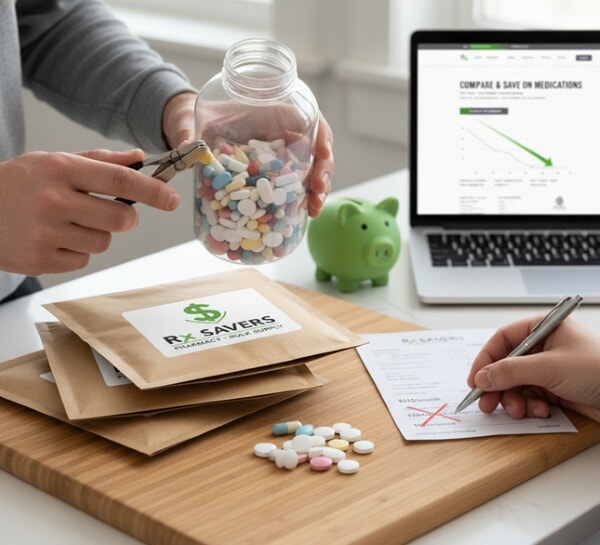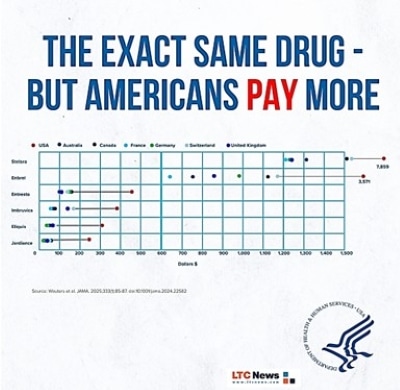How to Cut Costs on Life-Saving Medications in the U.S.

Table of Contents
- The Real Cost of Staying Alive
- Why Prescription Drugs Cost So Much
- Choose Generic Medications When Possible
- Use Patient Assistance Programs
- Save More with Online and Mail-Order Pharmacies
- Make Your Insurance Work for You
- Taking Control of the Cost of Care
- Managing Medication Costs in Long-Term Care Facilities
- Reducing Costs the Right Way
Prescription drug prices in the U.S. continue to soar, putting a financial strain on people managing chronic illnesses like diabetes. As you get older, the need for medication increases, and the financial strain can be substantial for some people.
Fortunately, you can use proven strategies, including generics, patient assistance programs, and verified pharmacy options, to safely cut costs and save you or a loved one money.
The Real Cost of Staying Alive
If you live with a chronic illness such as diabetes, heart disease, or rheumatoid arthritis, you know your prescriptions aren’t optional; they’re essential to survival and quality of life. Yet many adults find themselves forced to make impossible choices between paying for medication and covering other basic needs.
The U.S. has some of the highest prescription drug prices in the world. According to the U.S. Department of Health and Human Services (HHS), Americans pay more than three times the prices other OECD nations pay for brand-name drugs (even after accounting for discounts).

The American consumers have been subsidizing research and development costs for the entire planet. They put all of that on us, and yet they were the beneficiaries, too. — President Donald Trump.
Rising costs can lead to dangerous behaviors like skipping doses or rationing insulin, something no one should have to do.
Why Prescription Drugs Cost So Much
Understanding why medications are so expensive can help you make smarter choices about how to save. Several key factors drive U.S. drug pricing:
- Research and development costs: Pharmaceutical companies often cite R&D expenses as a major cost driver.
- Marketing and distribution: Direct-to-consumer advertising adds to final prices.
- Regulatory structure: Unlike many countries, the U.S. has no universal price controls.
- Insurance complexity: Formularies, co-pays, and deductibles can leave patients with big out-of-pocket bills.
For essential medications like insulin, these costs build over time. But knowing the system is the first step toward managing it.
The U.S. Department of Health and Human Services announced in May, 2025, that it is moving to implement President Donald Trump’s executive order, “Delivering Most-Favored-Nation Prescription Drug Pricing to American Patients.” The measure is a key part of the administration’s effort to lower health care costs.
HHS Secretary Robert F. Kennedy Jr. and Centers for Medicare and Medicaid Services Administrator Dr. Mehmet Oz said the agency has identified pricing targets pharmaceutical manufacturers must meet to comply with the order.
For too long, Americans have been forced to pay exorbitant prices for the same drugs that are sold overseas for far less. We expect pharmaceutical manufacturers to fulfill their commitment to lower prices for American patients, or we will take action to ensure they do. — HHS Secretary Robert F. Kennedy Jr.
Some experts say the current system can feel overwhelming, but patients have more power than they realize to lower prescription costs.
Choose Generic Medications When Possible
One of the easiest ways to cut prescription costs is to use generic medications. Generics have the same active ingredients as brand-name drugs and must meet the same FDA safety and quality standards.
By switching to a generic, you can save 50 percent or more on average, according to the U.S. Food and Drug Administration.
Steps to take:
- Ask your doctor or pharmacist if a generic alternative is available.
- Check whether your insurance covers the generic or if the out-of-pocket cost is lower.
- Consider pharmacy discount programs or apps that offer savings on generics.
Small changes in your prescription strategy can save you thousands of dollars annually.
Use Patient Assistance Programs
Many drug manufacturers offer patient assistance programs (PAPs) that provide discounted or free medications for those who qualify. These programs are often underused.
Key points to know:
- PAPs typically require proof of income or lack of insurance coverage.
- Some programs cover high-cost drugs like insulin and biologics.
- Your doctor’s office or a social worker can help with applications.
You can also search directories of assistance programs through nonprofit groups like NeedyMeds or Partnership for Prescription Assistance. Taking time to apply can ease long-term financial strain.
Understand the Rules on Buying from Abroad
Some patients turn to licensed Canadian pharmacies for lower-cost prescriptions. For those struggling with the high cost of insulin, for example, it is possible to buy Canadian insulin online, providing a reliable and affordable alternative to U.S. pharmacies.
Canada regulates drug prices, making many medications—including insulin—much cheaper. But importing medications comes with legal and safety considerations.
The FDA generally prohibits importing prescription medications that haven’t been approved in the United States. However, the agency uses its enforcement discretion to allow personal-use shipments.
If you’re considering sourcing medications internationally, only purchase from licensed and accredited pharmacies verified through trusted programs, such as the Canadian International Pharmacy Association (CIPA).
Generally, you can get a maximum 90-day supply of medication with a valid prescription from a licensed doctor. However, always talk with your doctor before starting or switching to any medication obtained outside the U.S. to make sure it’s safe, appropriate for your condition, and being monitored correctly.
When done safely and legally, this can offer significant savings. But failing to check credentials can expose you to counterfeit or unsafe products.
Save More with Online and Mail-Order Pharmacies
Online and mail-order pharmacies can reduce costs and improve convenience. Many offer lower overhead than local pharmacies, which can translate into better pricing. Some insurance plans also offer reduced co-pays for mail-order prescriptions.
Benefits of mail-order pharmacies:
- Discounted rates for bulk 90-day supplies.
- Auto-refill and delivery to your home.
- Easier management of chronic medication schedules.
Check your health plan to see if a preferred mail-order option is available and whether it can reduce your out-of-pocket costs.
Make Your Insurance Work for You
Even in a complex system, your insurance plan can be a powerful tool for managing medication expenses. Small adjustments can lead to big savings:
- Review your plan during open enrollment to ensure it covers your essential medications.
- Compare formulary tiers—some drugs may cost less if your doctor prescribes a preferred alternative.
- Ask your insurer about co-pay assistance or pharmacy partnerships that lower costs.
Insurance isn’t a guarantee of affordability, but informed choices can make it work harder for you.
Taking Control of the Cost of Care
You shouldn’t have to sacrifice your health because of drug costs. By understanding how pricing works and using practical tools like generics, assistance programs, safe international options, and strategic insurance use, you can ease the financial burden of managing chronic conditions.
Ask your doctor and pharmacist what cost-saving options are available to you. Start with one strategy and build from there.
👉 Reflective question: If your monthly medication bill suddenly doubled, what steps would you take to protect your health and your budget?
Managing Medication Costs in Long-Term Care Facilities
If your loved one lives in a long-term care facility, such as assisted living, memory care, or a nursing home, there are added layers of regulation and cost to consider.
Unlike at home, medications can’t simply be handed over or stored casually. Federal and state rules strictly govern how drugs are ordered, stored, and dispensed in these settings to protect residents and ensure compliance.
Most facilities work with a contracted pharmacy that packages and delivers medications in blister packs or unit doses. Nurses or trained medication aides administer each dose and record it in the Medication Administration Record (MAR). This documentation is required by the Centers for Medicare & Medicaid Services (CMS) and state health departments.
What Families Should Know
- No informal drop-offs: Families generally can’t bring in medication bottles from retail pharmacies or home. All medications must match a physician’s order, be properly labeled, and go through the facility’s medication management system.
- Strict storage rules: Medications are stored in locked medication rooms or carts. Residents can only keep medications in their rooms if they have a documented self-administration plan approved by the care team.
- Controlled substances: Opioids, anti-anxiety drugs, and other controlled medications are tracked carefully with witness logs and secure disposal protocols.
- Billing considerations: Facility pharmacies may charge different rates than retail pharmacies. Some plans allow families to use outside pharmacies, but the facility must approve it in advance to meet regulatory requirements.
Medication safety in long-term care is a regulated process, not a casual transaction. Families can help their loved ones save on costs, but it must be coordinated with the care team.
Reducing Costs the Right Way
You can still help reduce costs while following the rules:
- Work with your loved one’s primary care provider to ensure the prescription list is up to date.
- Ask the facility if generic substitutions are allowed through their pharmacy.
- Review insurance formularies to confirm coverage.
- If allowed, explore using a lower-cost outside pharmacy, but get written approval from the facility first.
- If your loved one qualifies, use manufacturer assistance programs or prescription discount cards to reduce out-of-pocket costs.
These steps can lower expenses without violating safety regulations or delaying essential medications.


